
Concept explainers
To explain: The leaf variegation in Mirabilis jalapa.
Introduction: Non-
To explain: The
Introduction: The difference in the leaf color of Mirabilis Jalapa is due to the presence of either green or colorless (white) chloroplast.
To explain: The phenotypes of progeny associated with the reciprocal cross between green female ♀ and variegated males ♂.
Introduction: The role of parental sex in trait inheritance can be determined using a reciprocal cross. This type of cross also reveals whether the trait is autosomal or sex-linked.
Want to see the full answer?
Check out a sample textbook solution
Chapter 3 Solutions
Introduction to Genetic Analysis
- Individuals of genotype AaBb were mated to individuals of genotype aabb. One thousand offspring were counted, with the following results: 474 Aabb, 480 aaBb, 20 AaBb, and 26 aabb. What type of cross is it? Are these loci linked? What are the two parental classes and the two recombinant classes of offspring? What is the percentage of recombination between these two loci? How many map units apart are they?arrow_forwardIn corn, the allele f ′ causes floury endosperm and the allele f ″ causes flinty endosperm. In the cross f ′/f ′ ×f ″/f ″, all the progeny endosperms are floury, but, in the reciprocal cross, all the progeny endosperms are flinty. What is a possible explanation? (Check the legend for Figure 2-7.)arrow_forwardGiven the following information, determine the inheritance of flower color in this plant and determine the genotypes of the parental individuals, which are from pure- breeding lines. CROSS 1 CROSS 2 purple X colorless all purple 9/16 purple colorless X red all purple as in Cross 1 F1 F1 F2 F2 3/16 red 4/16 colorlessarrow_forward
- The crossing of two orange-flowering plants results in ~2/3 orange-flower progeny and ~1/3 white-flower progeny. The crossing of two orange-flowering F1 plants generates the same progeny ratios as observed for the parental cross, while the crossing of white-flowering F1 plants only produces white-flowering progeny. What is a likely explanation for these results?arrow_forward. What is the basis for the green-and-white color variegation in the leaves of Mirabilis? If the following cross ismade,variegated / × green what progeny types can be predicted? What about thereciprocal cross?arrow_forwardThe crossing of two orange-flowering plants results in 61 orange-flower progeny and 27 white-flower progeny. The crossing of two orange-flowering F1 plants generates a similar progeny ratio as observed for the parental cross, while the crossing of white-flowering F1 plants only produces white-flowering progeny. What is a likely explanation for these results?arrow_forward
- A white F2 plant is allowed to self-fertilize. Of the progeny, 3/4 are white-flowered, and 1/4 are purple-flowered. What is the genotype of the white F2 plant?arrow_forwardIn a trihybrid cross of a tall, purple-flowered pea plant with round seeds (TtPpRr) with a short, white- flowered pea plant with round seeds (ttppRr), what is the probability: A) that a short, white-flowered plant with wrinkled seeds will be produced? B) that a tall, purple-flowered plant with round seeds will be produced? C) that a tall, white-flowered plant with round seeds will be produced?arrow_forwardWhat is the predicted phenotypic outcome of a dihybrid cross and a dihybrid text cross? Why?arrow_forward
- In some plants, a true-breeding, red-flowered variety gives all pink flowers when crossed with a white-flowered strain: RR (red) X rr (white) = Rr (pink). Flower position in this plant may either be axial (dominant) or terminal (recessive). What will be the phenotypic ratios of the F1 generation resulting from the following cross: axial-red (true-breeding) X terminal-white? What will the phenotypic ratios of the F2 be? SHOW ALL WORKarrow_forwardIn Mendelfruit plants, fruit may be either round (RR), long (rr) or oval (Rr). Cross two oval-fruit plants. What is the phenotypic ratio of the resulting offspring? (what do they LOOK LIKE?) Cross a round-fruit plant and an oval-fruit plant. Give the phenotypic ratio of the offspring.arrow_forwardIn the following cross, imagine that you have a female fly that has two Xs and one Y due to a nondisjunction event in her mother's germ cells. Draw out what the possible gametes are for both the female and the male and also a Punnett square showing the genotypes, phenotypes, and sex of the possible flies as a result of this cross. You do not need to provide the probabilities of each of these. Red-eyed wi C Ở Red-eyed wt XX Y X Y Meiosisarrow_forward
 Concepts of BiologyBiologyISBN:9781938168116Author:Samantha Fowler, Rebecca Roush, James WisePublisher:OpenStax College
Concepts of BiologyBiologyISBN:9781938168116Author:Samantha Fowler, Rebecca Roush, James WisePublisher:OpenStax College Biology (MindTap Course List)BiologyISBN:9781337392938Author:Eldra Solomon, Charles Martin, Diana W. Martin, Linda R. BergPublisher:Cengage Learning
Biology (MindTap Course List)BiologyISBN:9781337392938Author:Eldra Solomon, Charles Martin, Diana W. Martin, Linda R. BergPublisher:Cengage Learning

